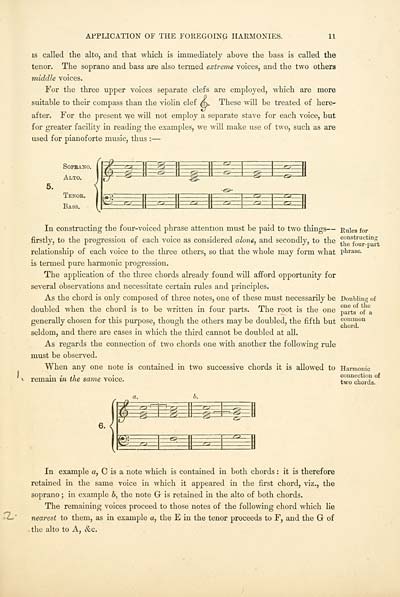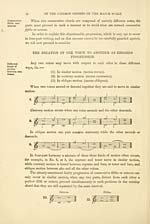Inglis Collection of printed music > Printed text > Treatise on harmony
(19) Page 11
Download files
Complete book:
Individual page:
Thumbnail gallery: Grid view | List view

AMPLICATION OF THE FOREGOING HARMONIES.
11
is called the alto, and that which is immediately above the bass is called the
tenor. The soprano and bass are also termed extreme voices, and the two others
middle voices.
For the three upper voices separate clefs are employed, which are more
suitable to their compass than the violin clef (fo. These will be treated of here-
after. For the present we will not employ a separate stave for each voice, but
for greater facility in reading the examples, we will make use of two, such as are
used for pianoforte music, thus : —
SOPBANO,
Alto.
In constructing the four-voiced phrase attention must be paid to two things —
firstly, to the progression of each voice as considered alone, and secondly, to the
relationship of each voice to the three others, so that the whole may form what
is termed pure harmonic progression.
The application of the three chords already found will afford opportunity for
several observations and necessitate certain rules and principles.
As the chord is only composed of three notes, one of these must necessarily be
doubled when the chord is to be written in four parts. The root is the one
generally chosen for this purpose, though the others may be doubled, the fifth but
seldom, and there are cases in which the third cannot be doubled at all.
As regards the connection of two chords one with another the following rule
must be observed.
When any one note is contained in two successive chords it is allowed to
remain in the same voice.
I
a.
b.
V
tk=^=
^ —
CJ.
Or s
— <s
CJ
/iV
<*J
[<*)•
vJ> rj
r-->
Rules for
constructing
the four-part
phrase.
Doubling of
one of the
parts of a
common
chord.
Harmonic
connection of
two chords.
In example a, C is a note which is contained in both chords : it is therefore
retained in the same voice in which it appeared in the first chord, viz., the
soprano ; in example b, the note G is retained in the alto of both chords.
The remaining voices proceed to those notes of the following chord which lie
nearest to them, as in example a, the E in the tenor proceeds to F, and the G of
the alto to A, &c.
11
is called the alto, and that which is immediately above the bass is called the
tenor. The soprano and bass are also termed extreme voices, and the two others
middle voices.
For the three upper voices separate clefs are employed, which are more
suitable to their compass than the violin clef (fo. These will be treated of here-
after. For the present we will not employ a separate stave for each voice, but
for greater facility in reading the examples, we will make use of two, such as are
used for pianoforte music, thus : —
SOPBANO,
Alto.
In constructing the four-voiced phrase attention must be paid to two things —
firstly, to the progression of each voice as considered alone, and secondly, to the
relationship of each voice to the three others, so that the whole may form what
is termed pure harmonic progression.
The application of the three chords already found will afford opportunity for
several observations and necessitate certain rules and principles.
As the chord is only composed of three notes, one of these must necessarily be
doubled when the chord is to be written in four parts. The root is the one
generally chosen for this purpose, though the others may be doubled, the fifth but
seldom, and there are cases in which the third cannot be doubled at all.
As regards the connection of two chords one with another the following rule
must be observed.
When any one note is contained in two successive chords it is allowed to
remain in the same voice.
I
a.
b.
V
tk=^=
^ —
CJ.
Or s
— <s
CJ
/iV
<*J
[<*)•
vJ> rj
r-->
Rules for
constructing
the four-part
phrase.
Doubling of
one of the
parts of a
common
chord.
Harmonic
connection of
two chords.
In example a, C is a note which is contained in both chords : it is therefore
retained in the same voice in which it appeared in the first chord, viz., the
soprano ; in example b, the note G is retained in the alto of both chords.
The remaining voices proceed to those notes of the following chord which lie
nearest to them, as in example a, the E in the tenor proceeds to F, and the G of
the alto to A, &c.
Set display mode to: Large image | Transcription
Images and transcriptions on this page, including medium image downloads, may be used under the Creative Commons Attribution 4.0 International Licence unless otherwise stated. ![]()
| Special collections of printed music > Inglis Collection of printed music > Printed text > Treatise on harmony > (19) Page 11 |
|---|
| Permanent URL | https://digital.nls.uk/94714316 |
|---|
| Description | Scottish and English songs, military music and keyboard music of the 18th and 19th centuries. These items are from the collection of Alexander Wood Inglis of Glencorse (1854 to 1929). Also includes a few manuscripts, some treatises and other books on the subject. |
|---|
| Description | The Glen Collection and the Inglis Collection represent mainly 18th and 19th century Scottish music, including Scottish songs. The collections of Berlioz and Verdi collected by bibliographer Cecil Hopkinson contain contemporary and later editions of the works of the two composers Berlioz and Verdi. |
|---|

